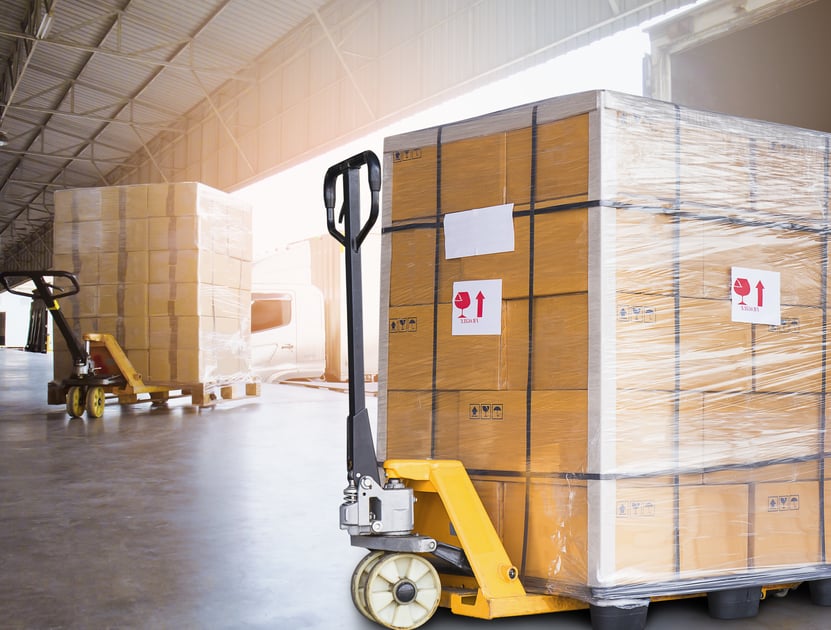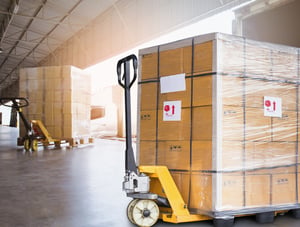
LTL shipments have earned the reputation for being susceptible to damage, loss and shortages, which is better known as OS&D (Over Short & Damage).
The problem with OS&D claims are they drive unexpected costs, delays, additional effort and unsatisfied customers.
OS&D is often a contentious back-and-forth discussion between the shipper and the LTL service provider with one blaming the other for the high percentage claim ratio.
In years past, there were a handful of LTL carriers or particular LTL hubs that were well known for having a reputation of high claims rates, but those have been addressed through improved processes, technology, management or buyers put them out of business altogether by not sending any business their direction.
While some of the biggest offenders have been shaken out of the market, OS&D is still a challenge for many LTL shippers.
The purpose of this article is to take the years of knowledge we have gained in helping shippers reduce their OS&D nightmare into a mole hill.
Now with the build-up in hand, here is where I will lose some of you because it will be hard to hear ...
From my 30+ years of experience, I have found 50% or more of OS&D issues can be traced right back to the shipper’s operation. The number is probably higher, but it's really hard for me to even admit a couple of the operations I had inherited over the years were really that bad.
While getting your head around where greater than 50% of the issues can be found may be hard to hear, please continue reading because I promise you’ll find points that will change your perspective and immediately reduce your OS&D headaches.
With the problem now scoped out, let's jump right into solving the problems with OS&D and it start with how LTL manages the workflow.
Defining the LTL Hub-and-Spoke Network Model
The linchpin in correcting LTL OS&D claims start with a shipper's outbound dock operators having a full understanding of the LTL hub-and-spoke operational model.
The hub-and-spoke network is the backbone of the largest and most successful LTL freight carriers.
The philosophy around hub-and-spoke is density and LTL consolidation. To achieve that goal, LTL carriers build line hauls at their transload facilities by combining freight from multiple shippers in the same region that then has similar destination points. This drives efficiencies in the LTL's line haul segment.

Let's walk through a more detailed description by using the above diagram. The far left diagram illustrates what LTL would look like if there was not a hub-and-spoke operation. Each piece of freight would have to travel individually across the country.
While the far right diagram uses the hub and spoke network where an LTL provider pools the freight at its origin cross-dock (hub) and sends all the freight in one trailer to the next cross-dock hub. At the destination hub, the multiple LTL pallets (spokes) are delivered out to their ultimate customer.
The above diagram was used to simplify the operations. The reality is that an LTL provider may not have the density to fill out a full line haul across the country, so what it will do is plan the freight to cross dock across multiple hubs to gain the density needed to move the freight as economically as possible.
The critical density requirements is why the freight market continues to see LTL merger and acquisition activity, while at the same time we do not see new entrants into the LTL market.
While the hub-and-spoke network method is efficient and effective, it does come with shortcomings that drive those less familiar with its impact on LTL crazy busy working through OS&D claims.
Top 5 Points for Shipping LTL Freight Successfully
Product Does not Travel the Way it is Loaded at the Origin Dock
The important take-away in the hub-and-spoke model is an LTL shipment will never travel through its entire journey from origin to destination, as it is loaded at the origin point. At a minimum, an LTL shipment will be touched twice, origin and destination hub, by the LTL carrier.
Worst case scenario is your shipment will be transferred every 550 miles.
The point of the LTL shipment hitting multiple hubs and therefore being repositioned in multiple trailers is the most often missed concept, yet the biggest driver of LTL OS&D claims.
The following items issues occur because this concept is missed:
- The operator believes the pallet they put on the top of the stack will always be on top.
- The pallets around the freight loaded on the LTL trailer will always be the same pallets.
With the two errors in thinking comes numerous issues around protecting the freight for the entire journey and just by taking a look into the LTL trailer your team is going to load out you'll see multiple operations are missing the point. The reason I say this is when looking into the trailer you would hope to see the most homogeneous looking product all tightly wrapped and within the confines of the pallets footprint. meaning without bulges on the sides or top.
So, before moving on to the next concept I want to emphasis that getting your dock workers to understand the concept freight is being touched a minimum of another two times before it hits the buyer dock will forever improve your company's OS&D claim ratio.
Pallet Selection: Quality and Size
A pallet serves two purposes: ease of conveyance and protection of the contents placed on it.
With that said, the quality of and size of a pallet plays a key role in LTL shipping.
With LTL freight being touched a minimum of two times, shippers cannot send out pallets that may break apart in transit or while being crossed dock at a transfer hub.
The pallet size must be appropriate for the packaging and product placed on it.
When a pallet’s contents go beyond the pallet dimensions, the product on the pallet rubs against other pallets in the trailer as they shift in transit. The rubbing over several hundred miles creates damage to the product. By keeping the contents of the pallet slightly within the pallet’s footprint, the protective nature of the pallet kicks in is as one pallet presses up against the other it is the pallet wood that rubs against the other pallet versus up against the product.
(Right: Example with product spilling out over the edges of the pallet, which later drove a claim.)
The next conclusion based on the previous paragraph might be to have a much larger pallet than the product on it, but that would be incorrect. The reason being is if the pallet is too large the product cannot securely stretch-wrapped for a secure transit.
Stretch-Wrapping a Pallet Serves Three Important Purposes
-
Holds its contents firmly in place.
-
Affixes the entire load on the skid to the skid itself.
-
Can be used to hide the contents of the product on the skid.
Let’s unpack each of the above purposes of shrink-wrapping a pallet.
Step 1: The stretch-wrapping must go around the bottom of the pallet and the first layer of contents on the skid a minimum of two times, with three times being optimal. This will secure the product to the skid. If this is not done, the entire cube of product will slide around over the skid in transit.
(Right: An example of how not to stretch wrap product to a pallet.)
Step 2: Once the bottom layer of product has been secured to the pallet, then the wrapping should gradually move up to the top layer of the pallet contents.
Step 3: The top layer should have a minimum of two wraps and go over the top boxes to secure them tightly.
Critical, critical point is stretch wrapping means exactly what it says. The wrapping must be stretched out by the operator as they wrap the pallet, so it does its job of shrinking back to then tighten the hold of the contents on the pallet.
Because not all dock works have the same strength or diligence in doing the job, we highly recommend purchasing a stretch wrap machine. The machine provides the tightest and most secure wrap of the product and will pay itself 100’s of times over again. The user can program the number of times the pallet wraps the bottom, top and on the way up the skid. Also note, the stretch machine will save 100's of times over again on OS&D claims, it will also save on the amount of stretch wrapping used by a company.
Product Packaging is Important
In today’s ecommerce world, where products move through a small parcel hub-and-spoke network, companies understands the importance of the integrity of their product's packaging to ensure their product looks perfect when it arrives at its customers’ doorsteps.
This thought process is often forgotten in the B2B world. The reason it is missed is the learning opportunity is lost because they never had their customer call center overloaded with damage claims from the end consumer.
So listen up B2B sellers. Packaging of raw goods is just as important as packaging for small parcel shipments. Make sure the packaging fits the product and the dock workers understand the importance of properly placing the product on the skid for a secure and safe transit.
Cube, Conveyance and Other Thoughts on Shipping LTL without Damage
 There are few more ideas to add to the conversation of shipping LTL successfully, but unlike the previous four topics that must be done by every LTL shipper the following depends on the shipper’s freight characteristics.
There are few more ideas to add to the conversation of shipping LTL successfully, but unlike the previous four topics that must be done by every LTL shipper the following depends on the shipper’s freight characteristics.
-
Corner Boards
- The purpose of corner boards is to protect the product on the skid and strengthen the integrity of the wrapped products on a pallet.
- Common applications:
- Unitizing for strength and integrity.
- Improve integrity of the stacked product.
- Provides additional support to the palletized product.
- Protects against damage caused by strapping.
- Protects the edges from damages caused in conveyance.
-
Black Shrink Wrap
- The purpose of black-out stretch wrapping is to conceal the contents of the product, so to reduce potential theft of the product.
-
Top Sheet
- The primary purpose is to protect the top layer of palletized items. The protection could be to simply keep dust out; protect against damage from other pallets stacked on top of it in transit or in the DC; and if a plastic top sheet is added it will protect against the infiltration of moisture.
Next Steps in Shipping LTL with Little to No OS&D Claims
Overall, companies have a huge opportunity to improve their OS&D claims ratios.
As the above 5 items indicate, education and training is the most economical method to improve.
A small investment of a stretch wrap machine can also take the operation a long way to improving the overall performance of your LTL shipping.
If you're ready to take the next step, at InTek Freight & Logistics, we can help. Just tell us what you need and we'll discuss how our expertise can help with the unique shipping challenges your business faces. Rather do a bit more research first? View our Freight Guides for comprehensive articles and eBooks on all things freight and logistics.
Other articles of interest associated with LTL and LTL brokerage:
Get Updates
Featured Articles
Categories
- Freight & Shipping Costs (54)
- Freight Broker (60)
- Freight Forwarder (2)
- Intermodal Transportation (184)
- International & Cross Border Logistics (43)
- Logistics & Supply Chain (420)
- Logistics Service Provider (77)
- LTL (39)
- Managed TMS (49)
- News (39)
- Supply Chain Sustainability (12)
- Transportation Management System (37)
- Truckload (122)
- Warehousing & Distribution (50)





